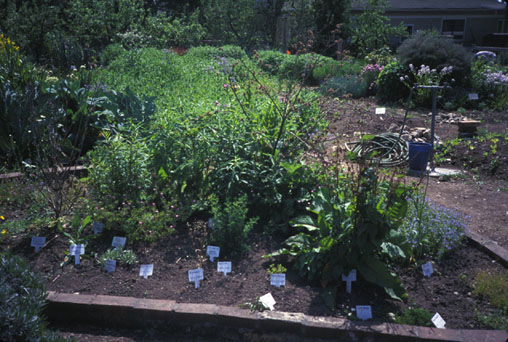
|
The Weed Patch
|
| Perhaps the most unusual of the many interesting Seattle Tilth Urban Agriculture Center demonstration plots at the Good Shepherd Center in Wallingford, is the one set aside solely for weeds. Here, visitors can learn the names, appearances and life histories of these often unwanted plants. Called "the weed patch," it consists of a rectangular plot about five feet wide by ten feet long, surrounded by a sturdy, neat wooden border of a natural light gray color. A conspicuous sign exclaims in bold letters WEEDS, and lists the names of the species in alphabetical order. |
| Depending on the time of year, anywhere from 30 to over twice that number of white plastic name tags are seen near the individual weed species they identify. Late spring finds the patch at its best, a veritable flower garden of beauty, commanding appreciative glances as a result of so many different kinds of herbs all close together and flowering at once. Summer becomes the congested season with weeds crowded "elbow to elbow;" a few such as foxglove, teasel and lambsquarters tower six feet or more; as many as 65 species of weeds may be seen all jammed into 50 square feet! Winter finds the patch at its nadir, only 25 to 30 species, but still a relative oasis of greenery compared to the nearby barren gardening plots. |
| The first weed plantings were made April 2, 1982. A few of those original plants are still present. No vandalism of any sort has been committed, and many gratified observers have warmly commended the project. Whether or not this weed patch is unique, it certainly is an unusual display. Gardeners who have spent years combating certain weeds in their yards, not able to curse the things by name, exhibit great pleasure at locating in the weed patch specimens of their bitter enemies, plainly labeled. Armed with this information, they are able to consult books to learn the best ways to eradicate or utilize these lowly but tenacious plants. People who have read in books about weeds, can visit the patch in order to see a living example. In short, the weeds are there for all who care to despise or admire them. |
| At first glance, the weed patch appears to be an indiscriminate mixture of plants, but is actually quite an exclusive gathering; space limitations are such that only a selected percentage of the city's weed species can be allowed admission, and then only in formal array. The planting plots are planned, with tall species in the middle and vines trained up posts. Poor examples are not brought into the patch, nor are dwarfish waifs that germinate and begin to grow in the patch countenanced. These policies may appear harsh, but once a specimen is admitted, it is permitted to stay until it dies (unless, as has occurred only in the case of the perennial sow-thistle, Sonchus arvensis, wantonly obnoxious behavior simply forces summary banishment). |
| The curator, in determining inclusion of a weed, considers the abundance of the species, its probable response to the weed patch environment, the size it might attain, its reproductive vigor, the number, if any, of very similar relatives, and the preferred and usual habitat of the species. Taken altogether, the favored weeds are the common, rather tame garden and lawn types; rarities and huge rampant field weeds are usually disdained. Yet, these are allowed in moderation when space permits or when there is exceptional beauty, notoriety or other singularity on the side of the weed. Thus, an unworthy weed can, as it were, "buy" its way in by somehow engaging the affections of the curator. |
| Over 80 species have been represented at one time or another, only seven or eight of which are native to our area. A conservative estimate of the herbaceous, terrestrial, vascular weed population of Seattle would be more than 225 species. (We forebear to attempt a definition of the term weed: suffice it to say, one need never search far to find them. Most in the weed patch were collected quite nearby.) |
| Those weeds officially sanctioned in the patch are given labels with English vernacular names. The list on the sign also supplies scientific names, and states whether the weeds are annual, biennial or perennial, edible or toxic. |
| Unauthorized weed seedlings are ever popping up. In general they are ruthlessly turned under or composted. The few that are given permission to grow receive an absolute minimum of watering and a thin, localized mulching in summer. If a weed cannot take care of itself, it has no business in a weed garden. |
| Flowering is encouraged because it makes for easier identification, besides adding color and beauty; yet reseeding is largely discouraged. An ingenious combination of miserably shallow, poor clayey soil (rich soil fosters lush vegetative growth), and continual "snipping off" of immature seeds induces the weed to keep flowering in a frantic effort to produce seeds. Those species that proliferate overzealously by underground means, are sometimes imprisoned in containers. Sheep sorrel (Rumex Acetosella) responded to this treatment by pining away, belike ready to die, and then creeping over the edge of its pot to escape. |
As the aforementioned regimen of maintenance is carried out on an irregular schedule, there are periods when the patch is truly messy, and other times when it is more attractive than the neighboring vegetable plots. A visitor therefore needs to observe the patch more than once; there will always be something new and worthwhile to see.
|
(Originally published in the Spring 1984 University of Washington Arboretum Bulletin. Since then the patch was enlarged and a non-rectangular brick border replaced its wooden one. (April 2005 was the 24th and last April that the bed was maintained by Arthur Lee Jacobson).)
Back |
|
|

